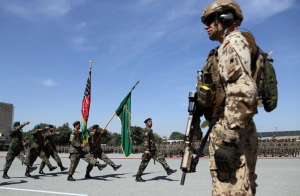
A member of NATO forces stands guard during the graduation ceremony of new Afghan National Army soldiers after a three-month training program at the Afghan Military Academy in Kabul on July 10. (Rahmat Gul/AP)
On July 7 — just hours after the U.S. envoy to Afghanistan, Zalmay Khalilzad, declared an imminent peace settlement with the insurgent group that could be finalized as early as Sept. 1 — the Taliban launched an attack in Ghazni, Afghanistan, resulting in at least 12 deaths. The blast was yet another reminder of the gaps in the ongoing U.S.-driven peace process. The top-down political negotiations might be a relief for the United States, whose troops have languished there for nearly two decades. But to achieve a sustainable resolution for Afghans, the peace process will need to include a far more elusive negotiation — a social settlement that fosters reconciliation and trust between the population and the government.
Much of the public discourse surrounding the talks has focused on how the agreement will play out in Kabul and internationally. It is not clear, however, how legitimizing the Taliban will affect the nearly three-quarters of the Afghan population living in rural and often remote areas. What faith can they have in a system that systematically eschews their interests, even though they endure the harshest circumstances — whether due to the mujahideen in the civil war or the Taliban thereafter? It is gross negligence for the Afghan government or the United States to assume that it can speak for such communities without first understanding them.
The reality is that more than three decades of conflict have resulted in deep fractures across Afghan society. The war has subverted social structures and defined a national psychology of fear, anxiety and anger. How, then, is peace possible in Afghanistan? Reconciling local fissures must occur before or alongside top-level political agreements. To push forward with the ongoing negotiations with the Taliban without addressing a national reconciliation plan is to treat Afghanistan’s past with complacency and hubris.
Yet the current dialogue with the Taliban risks doing just that. Amid high-level conferences and tweets, the absence of local Afghan constituents is palpable. The Taliban has sidelined the Afghan government as a U.S. puppet regime, and agreed to intra-Afghan talks only if Afghan leaders appeared in an unofficial capacity.
Taliban officials have also contradicted Khalilzad’s and Secretary of State Mike Pompeo’s claims that the intra-Afghan talks would negotiate peace or a cease-fire. In fact, Suhail Shaheen, a spokesman for the Taliban’s negotiating team, reiterated that such topics would only be broached after the United States announces a timeline for the withdrawal of foreign troops. These contradictions further erode the confidence and patience of the Afghan people.
With the next Afghan presidential elections slated for late September, the dialogue with the Taliban is not inherently unproductive. But it would be myopic for the United States or the Afghan government to assume a smooth and uneventful transition, particularly if foreign troops withdraw and the Taliban is given carte blanche in the central government.
At this critical juncture, the nascent but active Afghan civil society can mobilize outreach programs at a local level and address social grievances. This isn’t the stuff of bleeding-heart liberalism. It is common sense. Like an injured muscle, the Afghan population has to heal before it undertakes the task of nation-building.
This lesson was clear in Afghanistan’s own history. As the Soviet Army withdrew its troops in the late 1980s, Afghanistan seemed to breathe a single sigh of relief before imploding into a bitter civil war. Then-President Mohammad Najibullah turned to the Afghan people to put down their weapons and help repair the broken nation. In his National Reconciliation Policy (NRP), he called for an inclusive political settlement that would bring about a cease-fire with the mujahideen (now part of the political establishment in Kabul). He upheld a local consultative approach that balanced traditional Afghan decision-making norms with practical political strategies. The NRP gained significant traction in rural communities, even among those who had vehemently opposed the central government for its perceived secularism and Soviet ties. But despite support from the United Nations, the NRP’s success ultimately succumbed to an international and geopolitical environment that refused to sustain any associations with Russia.
Afghans such as Heela Najibullah are now revisiting the idea of national reconciliation. The former first daughter provides a compelling argument on the road map to peace in her book, “Reconciliation and Social Healing in Afghanistan.” The lessons are prescient: Peace requires a population that is not seething from injustice, that feels represented and heard, and whose interests are not consistently subsumed by international agendas.
Healing and reconciliation are not political unicorns. Many countries have been torn down by civil strife but emerged stronger with time. It takes political will to prioritize dialogue and understanding — yet a thorough, inclusive reconciliation process is crucial for Afghanistan’s long-term peace and stability.
Like any relationship, a sincere partnership stems from trust and respect. The current negotiations in Qatar and Afghanistan afford Afghan communities neither. Without engagement with the Afghan people, any resolution signed between the United States and the Taliban will not be wholly sustainable. It is worth finding out now, rather than later, whether the ink on paper would be a step forward or an indelible mistake.